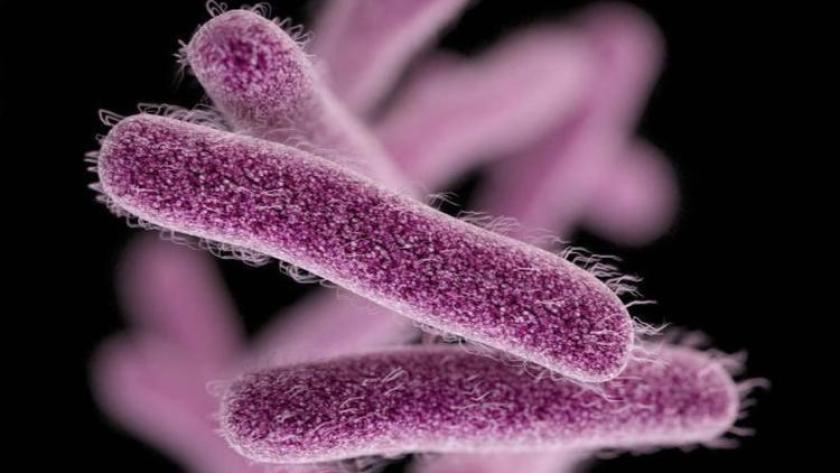
This computer rendering shows the structure of Shigella bacteria. Penn State researchers are helping public health officials identify possible infectious disease threats, so they can prepare prevention and treatment options. Image: U.S. Centers for Disease Control and Prevention
Whole genome sequencing may help officials get a handle on disease outbreaks
Posted on August 6, 2019UNIVERSITY PARK, Pa. — Whole genome sequencing technology may give epidemiologists and healthcare workers a powerful weapon in tracking and, possibly, controlling outbreaks of serious diseases, according to a team of researchers.
In a study, researchers found that both international and domestic sources of Shigella sonnei, which is the fourth most common cause of bacterial foodborne illnesses in the U.S., were from a related group of the bacteria, called Lineage II. Experts originally proposed that the international and domestic strains of Shigella were likely from different sources, according to the researchers, who published their findings in a recent issue of Microbial Genomics.
“One of the questions we asked was, genetically, are the domestic Shigella distinct from those that are coming internationally and, in the end, the answer was, no, they are not distinct — there doesn’t appear to be any stratification based on genetic relatedness,” said Edward Dudley, professor of food science at Penn State and associate of the Institute for CyberScience, which provides Penn State researchers access to supercomputing resources.
Because different strains of Shigella may require certain treatments, identifying the correct type of Shigella in a timely fashion could give public health officials a critical head start on both informing the public about the outbreak and alerting medical staff on best treatment options, according to Dudley, who is also the director of the E. coli Reference Center and associated with Penn State’s Huck Institutes of Life Sciences. Comparing Shigella samples during an outbreak could also give health officials the ability to identify possible sources of the disease, as well as help them monitor its progress and warn officials in locations that might lie in the outbreak’s path.
“In this study, with this particular species of Shigella, there were known to be five different lineages and we identified signatures in the genomes of these organisms that allow us to very rapidly say which of these five it segregates into,” said Dudley. “This helps the department of health to not only show how they can use whole genome technology for research, but maybe even how they can even use it to develop a new diagnostic tool.”
Shigella, which causes severe diarrhea and stomach discomfort, is typically passed through the stool. Because infected swimmers at public pools and swimming areas are often a common source of Shigella outbreaks, the quicker officials who run those facilities are alerted about a possible outbreak, the quicker they can take preventative action and issue warnings.
Whole genome sequencing can determine an organism’s complete genome, including the organism’s chromosomal DNA and mitochondrial DNA. According to Dudley, whole genome sequencing is faster and more accurate than pulsed-field gel electrophoresis, or PFGE, the previous standard test that only offered a basic genetic fingerprint of bacteria.
“DNA sequencing data is a lot clearer to look at — PFGE is more pattern based — and it’s a lot more specific,” said Dudley. “If you sequence the genome of the bacteria, you now have 5.5 million data points. If there’s a perfect match between the food and the patient, then it’s inarguable that there’s a relationship between the two of them.”
Whole genome analysis delivers results in a little over a day, which is much faster than PFGE. As computer technology advances, Dudley expects the speed of sequencing to increase, perhaps delivering results in a matter of hours.
In an earlier study, Dudley’s laboratory at Penn State also used whole genome analysis to study Salmonella, a leading cause of foodborne illnesses in the U.S. that causes about 450 deaths annually and is often associated with contaminated retail meats. In a paper published in Microbiology, the researchers said that Salmonella collected from people was genetically distinct from the types collected from the meats, such as ground turkey, pork chops and chicken breasts.
“By using the PFGE method, the Pennsylvania Department of Health concluded that human isolates and the meat isolates were identical,” said Dudley. “However, we could show them by using whole genome sequencing that — not so fast — you can actually distinguish them with this new method. So, from this, we could bolster the argument that these people were not getting sick from meats that were contaminated with those particular strains.”
The researchers used sequencing equipment at Penn State. For Shigella, the researchers sequenced a total of 22 isolated samples of the bacteria, also known as isolates — 11 from domestic sources and 11 international ones. Both sample sets were resistant to at least three classes of antibiotics.
In the Salmonella study, the team sequenced a total of 50 isolates of the bacteria.
The data collected by Penn State, as well as other laboratories, in the studies is stored on the FDA’s GenomeTrakr, a distributed network that allows researchers and public health officials to conduct real-time comparison and analysis to speed up foodborne illness outbreak investigations and reduce foodborne illnesses and deaths.
Rebecca Abelman, former research assistant in food sciences, Penn State and public health laboratory scientist, Maryland Department of Health; Hillary Figler, doctoral candidate in immunology and infectious disease, Penn State; and Nkuchia M’ikanatha, lead epidemiologist, Pennsylvania Department of Health, also worked on the Shigella study with Dudley.
Andrea Keefer, graduate student, and Lingzi Xiaoli, doctoral candidate, both in food sciences, Penn State; Kuan Yao, research fellow, and Maria Hoffman, research scientist,both of the U.S Food and Drug Administration; and also M’ikanatha worked with Dudley on the Salmonella study.
The U.S. Food and Drug Administration, the Centers for Disease Control and Prevention, and the U.S. Department of Agriculture supported this work.
